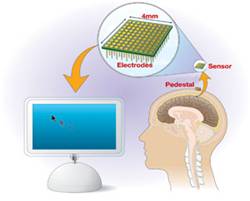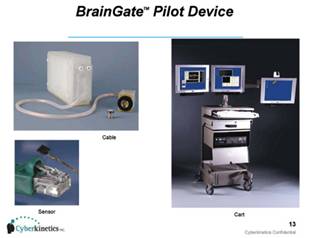





Published on Apr 02, 2024
BrainGate is a brain implant system developed by the bio-tech company Cyberkinetics in 2003 in conjunction with the Department of Neuroscience at Brown University. The device was designed to help those who have lost control of their limbs, or other bodily functions, such as patients with amyotrophic lateral sclerosis (ALS) or spinal cord injury.
The computer chip, which is implanted into the brain , monitors brain activity in the patient and converts the intention of the user into computer commands. Cyberkinetics describes that "such applications may include novel communications interfaces for motor impaired patients, as well as the monitoring and treatment of certain diseases which manifest themselves in patterns of brain activity, such as epilepsy and depression." Currently the chip uses 100 hair-thin electrodes that sense the electro-magnetic signature of neurons firing in specific areas of the brain, for example, the area that controls arm movement. The activities are translated into electrically charged signals and are then sent and decoded using a program, which can move either a robotic arm or a computer cursor. According to the Cyberkinetics' website, three patients have been implanted with the BrainGate system. The company has confirmed that one patient ( Matt Nagle ) has a spinal cord injury, while another has advanced ALS.

The Brain Gate Neural Interface System is currently the subject of a pilot clinical trial being conducted under an Investigational Device Exemption (IDE) from the FDA. The system is designed to restore functionality for a limited, immobile group of severely motor-impaired individuals. It is expected that people using the BrainGate System will employ a personal computer as the gateway to a range of self-directed activities. These activities may extend beyond typical computer functions (e.g., communication) to include the control of objects in the environment such as a telephone, a television and lights.
The BrainGate System is based on Cyberkinetics' platform technology to sense, transmit, analyze and apply the language of neurons. The System consists of a sensor that is implanted on the motor cortex of the brain and a device that analyzes brain signals. The principle of operation behind the BrainGate System is that with intact brain function, brain signals are generated even though they are not sent to the arms, hands and legs. The signals are interpreted and translated into cursor movements, offering the user an alternate "BrainGate pathway" to control a computer with thought, just as individuals who have the ability to move their hands use a mouse.
IBM, in partnership with scientists at Switzerland's Ecole Polytechnique Federale de Lausanne's (EPFL) Brain and Mind Institute will begin simulating the brain's biological systems and output the data as a working 3-dimensional model that will recreate the high-speed electro-chemical interactions that take place within the brain's interior. These include cognitive functions such as language, learning, perception and memory in addition to brain malfunction such as psychiatric disorders like depression and autism. From there, the modeling will expand to other regions of the brain and, if successful, shed light on the relationships between genetic, molecular and cognitive functions of the brain
The braingate pilot device consists of a Sensor of the size of a contact lens, a cable and pedestal, which connects the chip to the computer, a cart which consists the signal processing unit .

The BrainGate Neural Interface Device is a proprietary brain-computer interface that consists of an internal neural signal sensor and external processors that convert neural signals into an output signal under the users own control. The sensor consists of a tiny chip smaller than a baby aspirin, with one hundred electrode sensors each thinner than a hair that detect brain cell electrical activity.
The chip is implanted on the surface of the brain in the motor cortex area that controls movement. In the pilot version of the device, a cable connects the sensor to an external signal processor in a cart that contains computers. The computers translate brain activity and create the communication output using custom decoding software. Importantly, the entire BrainGate system was specifically designed for clinical use in humans and thus, its manufacture, assembly and testing are intended to meet human safety requirements. Five quadriplegics patients in all are enrolled in the pilot study, which was approved by the U.S. Food and Drug Administration (FDA).
There will be two surgeries, one to implant the BrainGate and one to remove it. Before surgery, there will be several precautionary measures in order to prevent infection; patients will have daily baths with antimicrobial soap and take antibiotics. In addition, MRI scans will be done to find the best place on the brain for the sensor. Under sterile conditions and general anesthesia, Doctor will drill a small hole into the skull and implant the sensor using the same methods as in the monkey studies. Patients will receive post-surgical care including a CT scan, some blood tests, and wound care in the hospital for 1 to 5 days after surgery. After surgery, one of the study doctors will see the patients at least once a week for six weeks, then monthly and as needed. A nurse will also check the patients regularly and will always carry a 24-hour pager. The skin around the pedestal will need to be carefully monitored during the study. Detailed instructions will be provided so that the patient’s daily care provider can help with skin care.
A brain-computer interface (BCI), sometimes called a direct neural interface or a brain-machine interface, is a direct communication pathway between a human or animal brain (or brain cell culture) and an external device. In one-way BCIs, computers either accept commands from the brain or send signals to it (for example, to restore vision) but not both. Two-way BCIs would allow brains and external devices to exchange information in both directions but have yet to be successfully implanted in animals or humans.In this definition, the word brain means the brain or nervous system of an organic life form rather than the mind. Computer means any processing or computational device, from simple circuits to silicon chips (including hypothetical future technologies such as quantum computing).
Research on BCIs began in the 1970s, but it wasn't until the mid-1990s that the first working experimental implants in humans appeared. Following years of animal experimentation, early working implants in humans now exist, designed to restore damaged hearing, sight and movement. The common thread throughout the research is the remarkable cortical plasticity of the brain, which often adapts to BCIs, treating prostheses controlled by implants as natural limbs. With recent advances in technology and knowledge, pioneering researchers could now conceivably attempt to produce BCIs that augment human functions rather than simply restoring them, previously only the realm of science fiction.
Neuroprosthetics is an area of neuroscience concerned with neural prostheses — using artificial devices to replace the function of impaired nervous systems or sensory organs. The most widely used neuroprosthetic device is the cochlear implant, which was implanted in approximately 100,000 people worldwide as of 2006. There are also several neuroprosthetic devices that aim to restore vision, including retinal implants, although this article only discusses implants directly into the brain.
The differences between BCIs and neuroprosthetics are mostly in the ways the terms are used: neuroprosthetics typically connect the nervous system, to a device, whereas the term “BCIs” usually connects the brain (or nervous system) with a computer system. Practical neuroprosthetics can be linked to any part of the nervous system, for example peripheral nerves, while the term "BCI" usually designates a narrower class of systems which interface with the central nervous system.
The terms are sometimes used interchangeably and for good reason. Neuroprosthetics and BCI seek to achieve the same aims, such as restoring sight, hearing, movement, ability to communicate, and even cognitive function. Both use similar experimental methods and surgical techniques.
The sensor of the size of a contact lens is implanted in brain’s percental gyrus which control hand and arm movements. A tiny wire connects the chip to a small pedestal secured in the scull. A cable connects the pedestal to a computer. The brain's 100bn neurons fire between 20 and 200 times a second .

The sensor implanted in the brain senses these electrical signals and passes to the pedestal through the wire. The pedestal passes this signals to the computer through the cable. The computer translates the signals into a communication output, allowing a person to move a cursor on a computer screen merely by thinking about it.
The BrainGate Neural Interface System is being designed to one day allow the user to interface with a computer and/or other devices at a level of speed, accuracy and precision that is comparable to, or even faster than, what is possible with the hands of a non-disabled person. The BrainGate System may offer substantial improvement over existing assistive technologies.Currently available assistive devices have significant limitations for both the person in need and the caregiver. For example, even simple switches must be adjusted frequently, a process that can be time consuming. In addition, these devices are often obtrusive and may prevent the user from being able to simultaneously use the device and at the same time establish eye contact or carry on conversations with others.
Potential advantages of the BrainGate System over other muscle driven or brain-based computer interface approaches include: its potential to interface with a computer without weeks or months of training; its potential to be used in an interactive environment, where the user's ability to operate the device is not affected by their speech, eye movements or ambient noise; and the ability to provide significantly more usefulness and utility than other approaches by connecting directly to the part of the brain that controls hand movement and gestures.
| Are you interested in this topic.Then mail to us immediately to get the full report.
email :- contactv2@gmail.com |